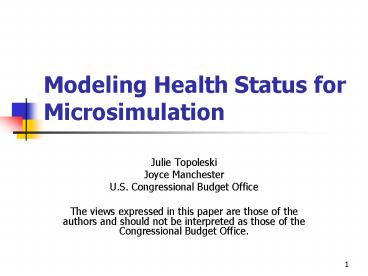Modeling Health Status for Microsimulation - PowerPoint PPT Presentation
1 / 17
Title:
Modeling Health Status for Microsimulation
Description:
CBOLT is based on longitudinal, administrative earnings from the Social Security ... At each step, examine relationship between predicted health status and various ... – PowerPoint PPT presentation
Number of Views:22
Avg rating:3.0/5.0
Title: Modeling Health Status for Microsimulation
1
Modeling Health Status for Microsimulation
- Julie Topoleski
- Joyce Manchester
- U.S. Congressional Budget Office
- The views expressed in this paper are those of
the authors and should not be interpreted as
those of the Congressional Budget Office.
2
Motivation
- The Congressional Budget Office analyzes
long-term effects of fiscal policy for the U.S.
Congress - We developed a microsimulation model to examine
Social Security over the next 75 years - We are now exploring Medicare, Medicaid, and
other health expenditures as well - We need health status and transitions to model
health expenditures
3
CBOs Long-Term Microsimulation Model
- CBOLT is based on longitudinal, administrative
earnings from the Social Security Administration - We impute many variables onto the administrative
data using survey data - CBOLT makes projections of Social Security,
Medicare, and Medicaid - But MM not currently projected at micro level
4
Background
- Large body of evidence indicates that an
individuals educational attainment and earnings
are strong predictors of health - Relationship also works in the opposite direction
- Including health status as a factor that affects
both demographic and economic outcomes is
critical when projecting financial solvency of
public pension and health programs
5
Projecting Health Status
- Use data from U.S. Survey of Income and Program
Participation merged with administrative earnings
and benefit data to estimate health status
transition equations - Predict self-reported health status
- Excellent, very good, good, fair, poor
6
Three-step approach
- First, estimate health status transitions
assuming only age, sex, and lagged health status
matter - Second, add additional covariates
- Education, marital status, household earnings
quintile - Third, add health status to mortality equations
- At each step, examine relationship between
predicted health status and various
characteristics (educ, earnings, mortality, )
7
Age-centered regressions
- Allows flexibility in the relationship between
health status and the underlying determinants
across age groups - Given the limited available data, estimating the
equations using data for just a single year of
age yields imprecise results - Age-centered approach uses every observation for
ages within a pre-set band (typically 4 years)
around the specific age group being analyzed
8
Assigning health status
- Given results of ordered logits and initial
health status assignment, each simulated
individual receives probability of transitioning
into each health status - Outcome depends on combination of probability and
a random draw - Logit rank procedure ensures right number of
individuals in each health status
9
Step 1a Health Status by Education(Health
status related only to age, sex, and lagged
health status)
10
Step 1b Health Status by Earnings Quintile
(Health status related only to age, sex, and
lagged health status)
11
Step 1c Average Mortality Rates(Health status
related only to age, sex, and lagged health
status)
12
Step 2a Health Status by Education(health
status depends on age, sex, lagged health and
other covariates)
13
Step 2b Health Status by Earnings Quintile
(health status depends on age, sex, lagged health
and other covariates)
14
Step 2c Average Mortality Rates(health status
depends on age, sex, lagged health and other
covariates)
15
Step 3 Average Mortality Rates(add health
status to mortality equations)
16
Comparison of Mortality Rates SIPP vs. CBOLT
17
Next Steps
- Additional work on refining the equations used in
the microsimulation model - Health could operate through many other pathways
- Disability status, labor force participation,
earnings levels, fertility, and even marital
status - Ultimately want to add health insurance status
and health expenditures to micro model































